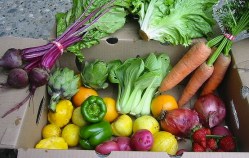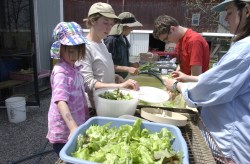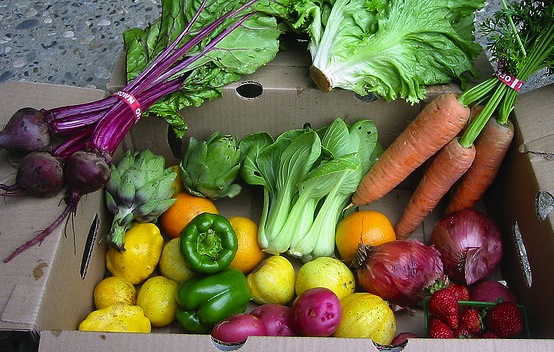
Photo by Mswine.
I was recently struck by a promotion I saw on the site Local Harvest, which lists organic and locally grown food around the country. The site reads, “Many farms offer subscriptions for weekly baskets of produce, flowers and other farm products. Try a CSA this year!”
“A subscription to local farm products?” I thought. “Is that all community-supported agriculture has become?”
As the local food movement has gone from a trickle to a sweeping current, and sales of local farm products have grown, it seems that many community-supported agriculture (CSA) subscribers may have lost touch with the original intention behind the term. As a farmer, and one who’s researched and written about the history of CSAs in the U.S. and abroad, I find this trend deeply troubling. It seems many urban residents now see the CSA as just another form of “retail farming” rather than a model for civic agriculture, a site-specific form of solidarity, or associative economics that can transform relationships.
In 1986, when the farmers behind Indian Line Farm and Temple-Wilton Community Farm started the first CSAs in this country, they were seeking solutions to the farm crisis that was driving people off the land. The number of family-scale farms was dropping every year. The work of food production — not to mention all of the risk — fell on the farmers, while prices rarely covered the costs of production, let alone provided a living wage. The CSA model invited local consumers to share the harvest and the risks by paying in advance for a whole season. They would feel a sense of ownership in the farm, and they took whatever the farm could produce in return.
The farmers at Indian Line Farm literally divided up the harvest of each week’s crop equally among the shareholders. Everyone participated — harvesting, weeding, or helping with distribution, promotion, or administration. Temple-Wilton separated the food from the price-per-pound mentality by summoning all members to an annual meeting where they made bids for payments to cover the farm budget. Once the season began, members took the amount of food they needed regardless of how much they had paid.
The value of commitment
Today, while many models like this still exist, there are also some CSAs that have abandoned entirely the notion of sharing the risk. In crowded markets like the San Francisco Bay Area, farms like Full Belly Farm and Capay Organic allow members to join for as little as one month. Farm Fresh to You, Capay Organic’s produce box service, and one of the largest in the country, advertises: “Customer Friendly, Flexible, Convenient — Cancel anytime — No commitment.”

All members of Genesee Valley Organic CSA play some role in the workings of the farm (these folks are washing vegetables).
The popularity of the CSA concept has also spawned imitators with no farm base at all, who use the local farm connection to lure customers to their convenient box delivery schemes. One local food service claims to run “very much like a community-supported agriculture, or CSA program.” But the entrepreneur-owner does not pay the farmers in advance or share the risk with them in any way. As the Wisconsin-based FairShare CSA website puts it, “These ‘box schemes’ source products from all over the country or world, just as most grocery stores do … You don’t build a relationship with any of the farmers involved and it may be difficult to even find out where something really came from.”
Dave Runsten of Community Alliance with Family Farmers in California tells me that the Department of Food and Agriculture in that state is working on an official definition of CSA. Runsten says the state plans to define single-farm CSAs and multi-farm CSAs, and they’re considering banning the use of the term by anyone buying from wholesalers or not requiring advance payment. That’s a start, but what about sharing the risk?
The United States Department of Agriculture defines CSA this way: “CSA consists of a community of individuals who pledge support to a farm operation so that the farmland becomes, either legally or spiritually, the community’s farm, with the growers and consumers providing mutual support and sharing the risks and benefits of food production.”
Meanwhile, Angelic Organics, a biodynamic farm in the Chicago area that supplies over 1,000 shares to members, describes the relationship in more colorful language:
When you sign up, you dedicate yourself to being our customer for the year, thus providing us a secure market — a welcome measure of certainty in the fickle world of farming! We, in turn, dedicate ourselves to being your farmers, providing you with a varied, nutritious vegetable diet. We do our very best to bring you a beautiful and bountiful box each week, but since our boss, Nature, provides no guarantees — we can’t offer any either. One of the premises of a Community Supported Agriculture program is that the shareholder shares, through the veggies, the farmers’ experience of nature’s mischief (and blessings).
Beyond convenience
In the 25 years since the first CSAs appeared, thousands of farms have adopted the model. Farms ranging in size from half an acre to hundreds of acres have benefited from the support of steady season-long sharers. The CSA model has also inspired and enabled an astonishing variety of farm-based projects with social service missions like the Homeless Garden Project in Santa Cruz, Calif., which employs homeless people, and Red Wiggler Community Farm in Pennsylvania, which gives meaningful work to adults with developmental disabilities.
Member involvement also varies tremendously. New York’s Genesee Valley Organic CSA and Missouri’s Fair Share Farm stand out as rare farmer-customer co-operatives — all members contribute, either by taking a core group job or helping with farm work and distribution. Vermont Valley Community Farm in Wisconsin recruits 50 of its 1,250 members to work as harvest crew, exchanging labor for vegetables. Still other CSAs make farm work voluntary or offer discounts to members who provide drop-off points.
Committed CSA members have also been known to make additional investments and loans to farms in need. This is a phenomenon I know firsthand. When my own farm, Peacework Organic Farm, needed financial support to secure land a few years back, our CSA members pitched in so that a local land trust could buy the farm and lease it back to us.
This isn’t the kind of community that we should take for granted.
And while some commercialization may be inevitable when a product of counterculture enters the mainstream the way the CSA model has, the conversations I hear about how “inconvenient” it is for consumers are missing the point.
As I see it, reducing CSA to a mere food box subscription scheme would castrate the CSA model, taking away its power to create lasting relationships between the people who grow and eat food. As Slow Food founder Carlo Petrini would say, CSAs allow citizens to become “co-producers” with their farmers, rather than passive consumers.
At their best, authentic CSAs are a win-win-win. Farmers get living wages and freedom from worry about profits and losses. Everyone weathers the tough times and benefits from the good times. Nothing goes to waste, and community investments help pay for land and equipment. Most of all, eaters get healthy food, good company, and the deep — if not always “convenient” — satisfaction that comes from playing an immediate role in transforming the food system.


